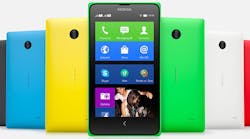WASHINGTON - Microsoft (IW 500/16) on Tuesday rolled out its first new Nokia (IW 1000/109) smartphone since acquiring the Finnish group's handset division -- using the Android operating system from arch-rival Google.
Microsoft said the Nokia X2, an updated version of a handset unveiled this year before the takeover was completed, was "designed to introduce the 'next billion' people to the mobile Internet and cloud services."
The device will be sold worldwide as a dual-SIM phone at a price of $135, Microsoft said in a statement.
While Microsoft has been struggling to get a foothold in the smartphone market with its Windows Phone operating system, the X2 "provides access to a world of Android apps and popular Microsoft services," the statement said.
Even though it uses the rival Android platform the X2 offers "a gateway to Microsoft services," including the Skype messaging program and OneDrive cloud storage.
The initial Nokia X was unveiled at the Mobile World Congress in Barcelona in February, before Microsoft completed its takeover of Nokia's handset division in April.
The new version cuts the price of a phone, which has had success in some countries.
"The Nokia X family is going from strength to strength, with the Nokia X smartphone achieving top-selling status in Pakistan, Russia, Kenya and Nigeria, while earning the third-best-selling smartphone spot in India," said Timo Toikkanen, head of mobile phones for the Microsoft Devices Group.
"The Nokia X2 elevates the Nokia X experience with a stellar new design, ease of use and new Microsoft experiences. We're proud to continue to bring smartphone innovation to lower and lower price points."
With the Nokia X unveiled in February, Android applications work, but users cannot access Google's services, notably its applications store, Google Play.
Tuesday's statement said users would have access to the Nokia Store as "the place for finding the highest-quality Android apps" for the device.
Windows Phone has managed to get only around 3.5% of the global smartphone market, while Android has more than 80%, according to recent figures from research firm IDC.
Copyright Agence France-Presse, 2014




